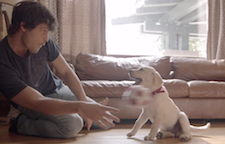Budweiser strikes again.
Once again, with the help of a puppy, the beer maker created another viral commercial. Earlier this year, it aired a Super Bowl commercial titled “Puppy Love” that I deconstructed for Poynter.org readers.
The new ad, “Friends are Waiting” comes with this cutline:
Next time you go out, be sure to make a plan to get home safely. Your friends are counting on you. Enjoy Budweiser responsibly. #FriendsAreWaiting
Watch the ad then let’s pull it apart to see what video storytelling lessons we can adapt to news writing:
The story uses a story frame I call:
Once Upon a Time — Suddenly — Fortunately — As it turns out
The playful pup falls in love with the man and the man adores the dog.
There are some interesting tensions along the way. The dog runs away with the leash, he chews on a shoe and at nine seconds in, even when the man is sick, the dog is there on the sofa comforting him. In just nine seconds, the story builds the relationship.
At 10 seconds we get the first hint this is a beer commercial. A beer bottle is sitting on the table next to a generic peanut butter jar. The bottle foreshadows something in the story.
At 15 seconds we get a second foreshadowing when the man walks down a pier and there is a towel on a chair, a towel with a Budweiser logo on it. Then again at 19 seconds everybody is gathered around the campfire drinking beer — all Budweisers.
At 20 seconds you see the people walking out of the house with a six-pack. Notice the panting sound of the dog. It is the first time you hear the dog in the whole spot. It is a sound of anxiety. It is a tension.
Then the commercial adds an action-reaction sequence. The people walk about, the dog is depressed.
He watches, then he waits, watches, waits.
The spot makes artistic use of lighting as the dog sniffs an old toy lying in a patch of light. The light of a passing car alerts him, but it is a false alarm, it is another tension builder.
At 33 seconds the night is gone, it is daylight outside the windows. At 35 seconds, once again, the dog makes a sound, a whimper.
The video goes to a white font over black background. The lyrics are replaced by soft guitar. It appears the story is over.
At 44 seconds the lyrics come back, the keys unlock the door, the dog comes back to full alert and at 47 seconds the dog makes his third sound as the master explains what happened and apologizes.
Notice that once the explosion of action occurs, the story ends quickly. That’s the best way to tell emotional stories. Don’t drag it out.
Think of this story frame as:
- Tension
- Context
- Explosion of Action
The context of the story is that when you leave home to party, somebody is counting on you to be responsible and come home safety. The dog is a great choice for this ad because we all want the dog to be happy. A cat wouldn’t care.
We can learn some much about news writing from watching, listening to and reading great stories of all kinds. Short stories like commercials are especially useful models to study because they are short, like most news stories. This spot never wastes my time, builds emotions and connections quickly, makes a clear solid point and leads to a resolution. We don’t know the dog’s name or the man’s name because we didn’t need to. The production is subtle and never competes with the message. The natural sound punctuates the story. Seemingly small things like lighting are not small.
The commercial also drills down on what I call story motivators. I think there are eight key motivators for storytellers to attach to their stories:
- Money
- Family
- Health
- Safety
- Community
- Moral Outrage
- Curiosity
- Social Trending
I bet that some will see a moral outrage in this commercial that goes something like, “How could he be out drinking while his poor dog has to wait to go outside and relieve himself?” But the more sure-fire motivators for this story are family and safety. REMEMBER: The more motivators you can use, the wider your audience will be.








Comments